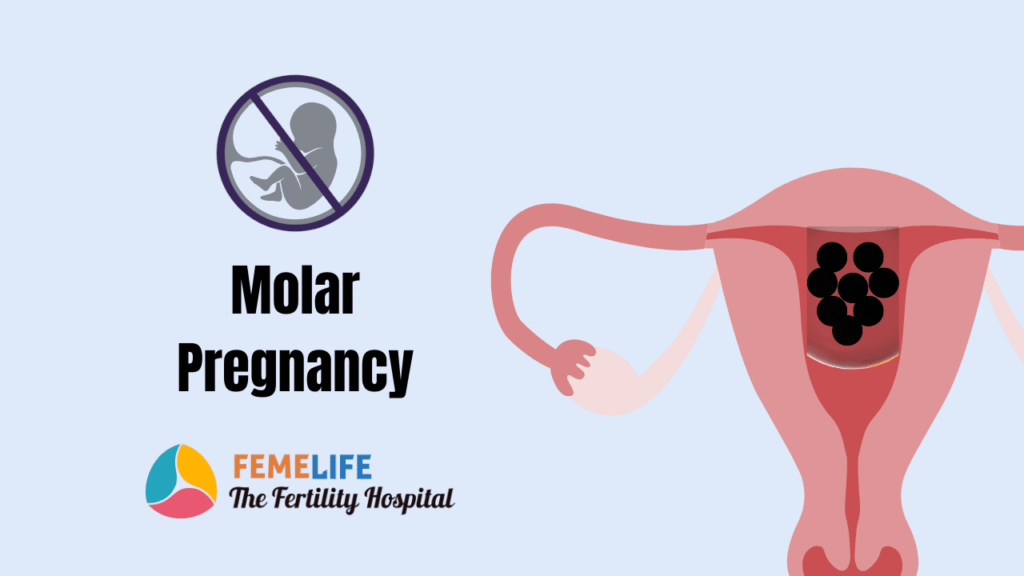A molar pregnancy is also known as gestational trophoblastic disease which is an abnormality of the placenta caused by a problem when the egg and sperm join together at fertilization. It is referred to as a hydatidiform mole or simply as a “mole”, this is a rare condition occurring in tissue.
A molar pregnancy occurs as the result of a genetic error during fertilization leading to the growth of abnormal tissue within the uterus.
They involve an embryo, and the growth of this material is compared to normal fetal growth. It appears as large as a collection of grape-like cell clusters. There are two varieties of molar pregnancies, one is “complete,” and another is “partial.”
Complete Molar Pregnancy:
Complete molar pregnancies have only placental parts which have no baby. It forms when the sperm of the husband fertilizes an empty egg. The placenta grows producing the pregnancy hormone HCG. An Ultrasound will show that there is the absence of a fetus and only a placenta.
Partial Molar Pregnancy:
- Partial Mole occurs where the mass contains both the abnormal cells and an embryo that has severe birth defects.
- In this case, the fetus of the patient will overcome by the growing abnormal mass rather quickly.
- A rare version of a partial mole occurs when twins are conceived but one embryo development is normal, while the other is a mole.
Symptoms:
- Vaginal spotting or bleeding
- Nausea and vomitting
- Develop rare complications like thyroid disorder
- Increased hCG levels
- No fetal movement or function of heart detected.
What causes molar pregnancy?
- Molar pregnancies are caused due to genetical errors that occur during the fertilization of an egg by a sperm.
- In a pregnancy, an embryo gets a set of chromosomes (23) from each parent which form a total of 46 chromosomes. Chromosomes are structures that contain genes and genetic information.
- Molar pregnancies contains imbalanced chromosomes.
- A complete molar pregnancy which has egg contains no chromosomes.
- The embryo gets 23 chromosomes from the sperm of husband. In a partial molar pregnancy, an egg fertilized two sperm which results in the embryo having 69 chromosomes leading to unsuccessful pregnancy.
How do you identify this situation?
An ultrasound of uterus often shows fluid-filled sacs instead of a placenta. There is usually no embryo or fetus in your uterus, but it may have the remaining of pregnancy tissues.
- In molar pregnancies, HCG is produced at abnormally higher levels in blood. A blood test can detect these high level that a molar pregnancy has occurred.
- Some people may not show up any symptoms, and the diagnosis can be quite shocking to the patients.
A molar pregnancy must be removed from body or it may lead to serious complications.
Treatment of molar pregnancy
People generally requires surgeries to remove molar pregnancies. Treatment involves curetting the uterus with suction to remove all abnormal tissue. General anaesthesia is given to avoid pain during surgery.
Some cases use medication to help your uterus contract and expel the contents of your uterus instead of surgery. The physician recommends best treatment for molar pregnancies to help prevent complications.
A hysterectomy or surgical removal of uterus is necessary to treat a molar pregnancy in rare cases.
The doctor will monitor HCG levels until levels return to normal. This shows that the molar tissue is gone whereas the HCG levels that don’t return to normal may indicate more serious complications.
What are the consequences?
Occasionally, few parts of this pregnancy remain in uterus after surgical treatment or miscarriage.
It leads to abnormal cells that may grow into the muscle layer around your uterus called as an invasive mole. This is rare, happens in less than 10% of people who have had operated with such condition.
Rarely, molar pregnancy causes a type of cancer called choriocarcinoma which forms within your uterus and may spread to other parts of body which requires cancer treatments such as chemotherapy or radiation.
Other complications of this situation include sepsis, uterine infection, preeclampsia (very high blood pressure), shock (very low blood pressure).
Can you prevent molar pregnancy?
- There is no way to prevent the patient with this condition.
- If you had a molar pregnancy, you can reduce the complications by avoiding another pregnancy for up to one year after your initial detection.
- Consult with the physician about when it’s safe to begin trying to conceive.

